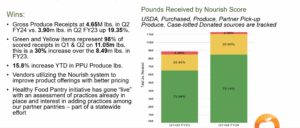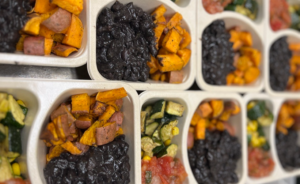Food banks exist to provide food for free to people who need it. Alameda County Community Food Bank is proving that food banks can also get paid for providing that food.
In February, the Calif.-based food bank received its first payment for providing healthy food to a patient on behalf of a local managed healthcare plan. It received enough in reimbursement to cover all the costs related to home-delivering two full bags of healthy proteins, grains and produce to the patient’s door. Now it is delivering food to about 20 patients.
“When we got our first payment, it was like, ‘Wow, it can be done,’” said Regi Young, who has led Alameda County Community Food Bank as Executive Director for the past two and a half years.

The food bank had been working toward getting reimbursed by insurance for healthy food even before Young came on board, he said, noting that California is among a handful of states that have made it possible through Medicaid 1115 waivers for organizations to get paid for providing healthy food to patients (see more here).
Since January, the food bank has been tapping funding from California’s Medicaid healthcare program, Medi-Cal, to home-deliver healthy food boxes. Its partners in the initiative include Alameda Alliance for Health, a nonprofit managed healthcare plan, and a local clinic.
The plan is to expand the service to 100 patients by the end of this fiscal year and to 200 by the end of next. There are about 400,000 MediCal beneficiaries in Alameda County, and most are likely to be eligible for this service, Young said.
The food bank is among the first hunger relief providers to enter a market that has already been broken open by private food box and meal companies. Even without government support through 1115 waivers, health insurers have been contracting with private meal companies to provide nutritious food to their patients, a benefit seen as able to cut medical costs by keeping clients healthy, while also increasing client satisfaction (see more here).
Young acknowledged the presence of for-profit meal providers in the market, and noted that food banks have something to offer that private meal providers do not: their connections into the vulnerable communities that most need the nutritious food.
Going forward, the food bank hopes to go beyond getting patient referrals from healthcare providers to also soliciting referrals through its food pantry network. “We’re trying to explore if there is a space for food banks to have a competitive advantage based upon the connections we already have with partners in the community,” Young said.
Doing so would require pantry agencies to be able to identify clients who are eligible for the service, and then enroll them in it. “The way I think about it is – how do we programmatize it within our network, as opposed to just programmatizing it outside of our network through partnerships with healthcare,” Young said.
There would be plenty of challenges to getting food pantries involved in signing clients up for reimbursed food services. The food bank itself is still trying to understand the healthcare workflows, infrastructure and terminology related to its current 20-patient caseload, Young said.
Expanding to additional plans, providers and pantries would surely add complexity. “You don’t want to create more infrastructure for the pantries who are already doing a ton of work,” he noted. Even so, there is the “possibility to create something that’s easy for pantries to utilize and easy for their clients to engage with. And I think a lot of those lessons are going to come from our burgeoning relationship on the clinical side,” Young said.
To support its entry into reimbursed services, the food bank hired a team member with a strong background in healthcare partnerships. Originally hired as the Countywide Health Systems Liaison, that staffer, Rebecca Murillo (pictured above), is now the Food as Medicine Manager. The food bank also partnered with a claims billing software provider, EZClaim. The EZClaim software connects into a clearinghouse that maintains eligibility information on Medi-Cal members, which helps flag any member issues that could result in a claim rejection.
Now that the food bank has proven the concept of getting reimbursed, it is looking forward to scaling up the initiative while also figuring out ways to broaden its reach. The current Medicaid legislation says that food can only be a covered benefit for food-insecure patients who also have a chronic disease, like diabetes or a heart condition. Young would like to see eligibility expanded to include people who are simply food-insecure. “What would it look like, if larger aspects of our work were reimbursed in a similar way,” Young asked.
The trickle of reimbursement money that the food bank is currently receiving offers an inkling of the potential of getting paid to do the work the food bank already does for free. “The biggest opportunity is moving this towards an effort in which food could actually be covered as a health benefit,” Young said. “That would be a game-changer.” – Chris Costanzo
CAPTION FOR PHOTO ABOVE: Rebecca Murillo was hired to advance Alameda County Community Food Bank’s liaisons in the healthcare community.
Like what you’re reading?
Support Food Bank News
This article was made possible by the readers who support Food Bank News, a national, editorially independent, nonprofit media organization. Food Bank News is not funded by any government agencies, nor is it part of a larger association or corporation. Your support helps ensure our continued solutions-oriented coverage of best practices in hunger relief. Thank you!
Connect with Us:










